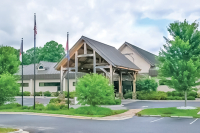Open season: Crack down on wild boar may meet resistance from hunters
There’s a new call to arms for hunters of wild boar: shoot as many as you can — day or night, anytime of year — and ask questions later.
Wild boar are a reviled scourge on the landscape. Yet until now, hunters couldn’t shoot more than two per person and the hunting season was limited to only six months of the year in the six western counties.
The game laws didn’t make sense given the nearly universal loathing of wild boar, prompting the N.C. Wildlife Resources Commission to consider a more liberal hunting policy toward the animal.
The open invitation to hunt them in mass quantities is a plea to hunters to help get rid of the destructive beasts that have taken root in the mountains despite not belonging here.
“Ideally, statewide from the mountains to the coast, all feral swine would disappear,” said Evin Stanford, a wild boar expert with the N.C. Wildlife Resources Commission.
But the hunting community might not be so eager to see wild boar wiped out.
Related Items
“I like to hunt them, and I would hate for them to be eradicated,” said Curtis Bradley, a hunter from Canton and member of the WNC Sportsman’s Club.
Many hunters don’t like the idea of an open, year-round season with no bag limits. Bag limits are intended to protect game animals from over hunting, ensuring their viability as a huntable species in the future.
“I think the ones that actually hunt them wouldn’t want the bag limits to go away,” Bradley said.
Hunters are expected to voice their disapproval at a public hearing on the new hunting laws for feral swine being held at 7 p.m. Wednesday (Sept. 14) at Haywood Community College by the N.C. Wildlife Commission.
Ecologists have a different view, however. Feral swine are nature’s version of a bulldozer, devouring everything in their path and leaving a wake of uprooted earth.
The hunting changes will apply in the six western counties. In the rest of the state, hunters can already shoot an unlimited number of wild boar all year. The change will bring the six western counties in line with the long-standing policy toward wild boar everywhere else.
In fact, they aren’t even called wild boar in the rest of the state, but instead are bestowed with the far less romantic name “feral swine.”
“Everything is wide open on feral swine outside those six western counties,” Stanford said. “Our agency for a long time has not seen them as a desirable species on the landscape.”
Saying so publicly is a big step for the Wildlife Commission, however, which until now has been swayed by hunting interests when it comes to wild boar in the mountains.
“In that part of the state it is a traditional big game species that has been hunted for generations,” Stanford said.
The Wildlife Commission had attempted to balance interests of wild boar hunters with the ecological harm wrought by the species. But it now seems poised to buck pressure from the hunting community and shed the special status for wild boar that had persisted in the far western mountains.
“I think that was a fight we thought at one time we could not win,” Stanford said. “It seems the tradition of hunting wild boar has been waning, at least compared to 20, 30, 40 years ago.”
The Great Smoky Mountains National Park, where hunting isn’t allowed anyway and the ecosystem always comes first, was alone in its admitted mission to eradicate wild boar until recently. The Smokies has made an impressive dent in the wild hog population by trapping. Realistically, they’ll never get rid of them completely, but hope to keep them in check.
“It is definitely a daunting task, given the manpower and the amount of area we have,” said Bill Stiver, wildlife biologist in the national park. But, “We have kept the pressure on.”
Until recently, however, the Smokies begrudgingly turned over some of the boar it trapped to the U.S. Forest Service, which in turn set them free in the Nantahala National Forest. The Smokies’ more rugged stock of wild boar is particularly desired by the hunting community, which pressured the forest service to save the wild boar from the Smokies’ traps and release them in the forest. The practice wasn’t ended until 2005.
Rogue introductions
Fringe elements in the hunting community have been doing their part to keep the species alive and well in the state, albeit illegally. Rogue hunters are suspected of releasing hogs and pigs into the forests to boost the feral swine population and counter efforts to eradicate them.
While no one has been caught in the act, Stiver has encountered feral swine in the wild with pale skin, curly tails, smooth skin, even spots — signs of domestic pigs rather than the course-haired, tusked feral cousins.
“Historically wild boar in the park were traditionally black. They had that Russian look. But in recent years we’ve seen hogs with much shorter snouts, with much shorter legs, animals that appear to be semi-domesticated,” Stiver said. “They just stand there. They had no fear of people as if they had been in a pen and then been let loose.”
That, more so than pigs accidentally escaping from farmers, is how the population of feral swine has spread across the state.
“In most instances the population is established by individuals intentionally releasing feral swine with the intention of establishing a population that could be hunted,” Stanford said.
It has been illegal to release swine into the wild for several years, but it technically wasn’t illegal to move them.
“Individuals could trap swine and move them up and down the roadways and there was no violation involved,” Stanford said.
That loophole was closed with a new state law this year, banning the transport of live hogs without identification approved by the state veterinarian, so now only hog farmers can legally transport their livestock.
The law also prohibits the removal of live feral hogs from traps. Anyone trapping a feral hog has to kill it inside the trap before opening the door — removing any doubt over whether “relocating” feral swine versus “releasing” them is legal or not. It also gives wildlife officers more ammunition to crack down on rogue introductions.
Oddly, an open season on feral swine — allowing hunters to shoot as many as they want year-round — can backfire. Those who like hunting feral swine are tempted to set out new animals to keep the population viable and huntable.
Some states are trying a novel solution
In Tennessee, hunting wild boar was outlawed this year for most parts of the state.
“The strategy we are going after is pretty radical, but a very aggressive approach at eradicating hogs across the state,” said Grey Anderson, a wildlife biologist with the Tennessee Wildlife Commission. “It is a little against the grain. The traditional method is to liberalize your season, and then you get more hunters and it reduces the population.”
But Tennessee found that quite the opposite played out on the ground. After changing its wild hog hunting rules in 1999 — lifting the bag limits and allowing year-round hunting — the population actually increased. The reason is no surprise: hunters launched rogue campaign of illegally releasing hogs in the wild, resulting in more feral swine instead of less, Anderson said.
“It was counter productive to what we were trying to do,” Anderson said.
Kansas was the first to try the alternative strategy, and Tennessee decided it was worth a try. Hunters aren’t too pleased, however.
“We are getting a ton of pushback now,” Anderson said.
Now that hunting wild hogs is illegal, the Tennessee Wildlife Commission has started trapping and killing them itself. Without hunters propagating the species, however, Anderson believes the agency will be able to make a dent in the population.
There is one exception to Tennessee’s new policy. In the mountains of East Tennessee around the Smokies, wild boar hunting is still allowed under some circumstances. If hunters are hunting bear or deer and come across wild hogs, they are allowed to shoot them.
“If your bear dogs get on a hog trail you can take them,” Anderson said.
The reason is a familiar one: a storied tradition of wild boar hunting in the mountains.
“They have been hunting wild hogs in that part of the world that we know of since the early 1900s. There is a very strong tradition of hunting,”Anderson said, Agricultural interests are backing North Carolina’s crack down on feral swine. Feral swine carry lethal diseases, including several documented cases of pseudrabies.
“They are tremendous risk to our domestic livestock and swine industry,” Stanford said.
Going native
Most of the feral swine in the state are descendants of domestic hogs turned out by early settlers to graze on the open range, or in more recent decades, animals that have been purposely released. After a few generations in the wild, they start to sport hair and tusks.
“In as soon as three generations they can start to develop some of the feral traits,” Stanford said. “They start to revert relatively quickly.”
Wild boar lineage is unique in the far western mountains, however. Here, their ancestry can be traced back to the true European wild boar.
A stock of European wild boar was imported by a hunting preserve in 1912 in the Hooper’s Bald area of the Smokies. In 1920, they all escaped, with estimates ranging from 60 to 100 of the beasts.
This genetic line still lingers in mountain wild boar, but has been dramatically watered down by domestic swine injected into the population.
Feral swine are unfortunate proliferators. Mothers have five to six young a year on average, and in a bumper year for acorns or other food mainstays, they can have two litters a year. They are fertile at just a year old.
The young pigs stick close to their giant mothers, and probably have pretty low mortality from predators such as coyotes or bobcat, Stanford said. As adults, humans are their only enemy.
Bradley, who has hunted wild boar on game lands in Swain and Jackson counties, said it is a challenge to hunt them, mostly because you can’t find them. They don’t frequent the same place day after day. They come through, eat, then move on.
“You can go out there for an entire season and never see a single one. You will see the remnants of them, where they have torn the woods up,” Bradley said. But, “It may be weeks before they come back through there.”
Bradley is no stranger to hogs. His family ran a hog farm and slaughter house in Jackson County for 100 years, going back four generations. He is the first to agree feral swine are destructive.
“When they tear it up, they tear it up big time. They come through like a carpet roller,” Bradley said.
Bradley believes the N.C. Wildlife Commission is giving in to political pressure from the growing number of upscale subdivisions in the mountains pushing into the forest habitats, and then complaining about the animals in their yards.
“You got a lot of influx of people and they want to change the rules to suit their lifestyle,” Bradley said.









